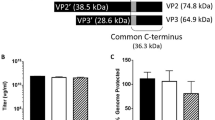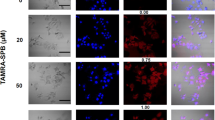Abstract
Survival of patients with pancreatic cancer is poor. Adenoviral (Ad) gene therapy employing the commonly used serotype 5 reveals limited transduction efficiency due to the low amount of coxsackie-adenovirus receptor on pancreatic cancer cells. To identify fiber-chimeric adenoviruses with improved gene transfer, a library of Ad vectors based on Ad5 and carrying fiber molecules consisting of 16 other serotypes were transduced to human pancreatic carcinoma cell lines. Adenoviruses containing fibers from serotype 16 and 50 showed increased gene transfer and were further analyzed. In a gene-directed prodrug activation system using cytosine deaminase, these adenoviruses proved to be effective in eradicating primary pancreatic tumor cells. Fiber-chimeric Ad5 containing fiber 16 and wild-type Ad5 were also transduced ex vivo to slices of normal human pancreatic tissue and pancreatic carcinoma tissue obtained during surgery. It was shown that fiber-chimeric Ad5 with fiber 16 revealed an improved gene delivery to primary pancreatic tumor tissue compared to Ad5. In conclusion, fiber-chimeric adenoviruses carrying fiber 16 and 50 reveal a significantly enhanced gene transfer and an increased specificity to human pancreatic adenocarcinoma compared to Ad5, whereas transduction to normal pancreatic tissue was decreased. These findings expand the therapeutic window of Ad gene therapy for pancreatic cancer.
This is a preview of subscription content, access via your institution
Access options
Subscribe to this journal
Receive 12 print issues and online access
$259.00 per year
only $21.58 per issue
Buy this article
- Purchase on Springer Link
- Instant access to full article PDF
Prices may be subject to local taxes which are calculated during checkout






Similar content being viewed by others
References
Jemal A, Siegel R, Ward E, Hao Y, Xu J, Murray T et al. Cancer statistics, 2008. CA Cancer J Clin 2008; 58: 71–96.
Kuhlmann KF, de Castro SM, Wesseling JG, ten Kate FJ, Offerhaus GJ, Busch OR et al. Surgical treatment of pancreatic adenocarcinoma: actual survival and prognostic factors in 343 patients. Eur J Cancer 2004; 40: 549–558.
Neoptolemos JP, Stocken DD, Friess H, Bassi C, Dunn JA, Hickey H et al. A randomized trial of chemoradiotherapy and chemotherapy after resection of pancreatic cancer. N Engl J Med 2004; 350: 1200–1210.
Bischoff JR, Kirn DH, Williams A, Heise C, Horn S, Muna M et al. An adenovirus mutant that replicates selectively in p53-deficient human tumor cells. Science 1996; 274: 373–376.
Fueyo J, Gomez-Manzano C, Alemany R, Lee PS, McDonnell TJ, Mitlianga P et al. A mutant oncolytic adenovirus targeting the Rb pathway produces anti-glioma effect in vivo. Oncogene 2000; 19: 2–12.
Bergelson JM, Cunningham JA, Droguett G, Kurt-Jones EA, Krithivas A, Hong JS et al. Isolation of a common receptor for Coxsackie B viruses and adenoviruses 2 and 5. Science 1997; 275: 1320–1323.
Wesseling JG, Bosma PJ, Krasnykh V, Kashentseva EA, Blackwell JL, Reynolds PN et al. Improved gene transfer efficiency to primary and established human pancreatic carcinoma target cells via epidermal growth factor receptor and integrin-targeted adenoviral vectors. Gene Therapy 2001; 8: 969–976.
Pearson AS, Koch PE, Atkinson N, Xiong M, Finberg RW, Roth JA et al. Factors limiting adenovirus-mediated gene transfer into human lung and pancreatic cancer cell lines. Clin Cancer Res 1999; 5: 4208–4213.
Hecht JR, Bedford R, Abbruzzese JL, Lahoti S, Reid TR, Soetikno RM et al. A phase I/II trial of intratumoral endoscopic ultrasound injection of ONYX-015 with intravenous gemcitabine in unresectable pancreatic carcinoma. Clin Cancer Res 2003; 9: 555–561.
Mulvihill S, Warren R, Venook A, Adler A, Randlev B, Heise C et al. Safety and feasibility of injection with an E1B-55 kDa gene-deleted, replication-selective adenovirus (ONYX-015) into primary carcinomas of the pancreas: a phase I trial. Gene Therapy 2001; 8: 308–315.
Havenga MJ, Lemckert AA, Grimbergen JM, Vogels R, Huisman LG, Valerio D et al. Improved adenovirus vectors for infection of cardiovascular tissues. J Virol 2001; 75: 3335–3342.
Havenga MJ, Lemckert AA, Ophorst OJ, van Meijer M, Germeraad WT, Grimbergen J et al. Exploiting the natural diversity in adenovirus tropism for therapy and prevention of disease. J Virol 2002; 76: 4612–4620.
Shenk T . Adenoviridae. In: Knipe DM, Howley PM (eds). Fields Virology. Lippincott Williams and Wilkins: Philadelphia, 2001: 2265–2301.
Fallaux FJ, Bout A, van der Velde I, van den Wollenberg DJ, Hehir KM, Keegan J et al. New helper cells and matched early region 1-deleted adenovirus vectors prevent generation of replication-competent adenoviruses. Hum Gene Ther 1998; 9: 1909–1917.
Zhang WW, Koch PE, Roth JA . Detection of wild-type contamination in a recombinant adenoviral preparation by PCR. Biotechniques 1995; 18: 444–447.
Rea D, Havenga MJ, van Den AM, Sutmuller RP, Lemckert A, Hoeben RC et al. Highly efficient transduction of human monocyte-derived dendritic cells with subgroup B fiber-modified adenovirus vectors enhances transgene-encoded antigen presentation to cytotoxic T cells. J Immunol 2001; 166: 5236–5244.
Mullen CA, Kilstrup M, Blaese RM . Transfer of the bacterial gene for cytosine deaminase to mammalian cells confers lethal sensitivity to 5-fluorocytosine: a negative selection system. Proc Natl Acad Sci USA 1992; 89: 33–37.
Shabram PW, Giroux DD, Goudreau AM, Gregory RJ, Horn MT, Huyghe BG et al. Analytical anion-exchange HPLC of recombinant type-5 adenoviral particles. Hum Gene Ther 1997; 8: 453–465.
Hehir KM, Armentano D, Cardoza LM, Choquette TL, Berthelette PB, White GA et al. Molecular characterization of replication-competent variants of adenovirus vectors and genome modifications to prevent their occurrence. J Virol 1996; 70: 8459–8467.
Ma L, Bluyssen HA, De Raeymaeker M, Laurysens V, van der Beek N, Pavliska H et al. Rapid determination of adenoviral vector titers by quantitative real-time PCR. J Virol Methods 2001; 93: 181–188.
Seglen PO . Hepatocyte suspensions and cultures as tools in experimental carcinogenesis. J Toxicol Environ Health 1979; 5: 551–560.
Krasnykh VN, Mikheeva GV, Douglas JT, Curiel DT . Generation of recombinant adenovirus vectors with modified fibers for altering viral tropism. J Virol 1996; 70: 6839–6846.
Olinga P, Groen K, Hof IH, De Kanter R, Koster HJ, Leeman WR et al. Comparison of five incubation systems for rat liver slices using functional and viability parameters. J Pharmacol Toxicol Methods 1997; 38: 59–69.
Shayakhmetov DM, Li ZY, Ni S, Lieber A . Targeting of adenovirus vectors to tumor cells does not enable efficient transduction of breast cancer metastases. Cancer Res 2002; 62: 1063–1068.
Kanerva A, Wang M, Bauerschmitz GJ, Lam JT, Desmond RA, Bhoola SM et al. Gene transfer to ovarian cancer versus normal tissues with fiber-modified adenoviruses. Mol Ther 2002; 5: 695–704.
Li Y, Pong RC, Bergelson JM, Hall MC, Sagalowsky AI, Tseng CP et al. Loss of adenoviral receptor expression in human bladder cancer cells: a potential impact on the efficacy of gene therapy. Cancer Res 1999; 59: 325–330.
Hemminki A, Kanerva A, Liu B, Wang M, Alvarez RD, Siegal GP et al. Modulation of coxsackie-adenovirus receptor expression for increased adenoviral transgene expression. Cancer Res 2003; 63: 847–853.
Anders M, Christian C, McMahon M, McCormick F, Korn WM . Inhibition of the Raf/MEK/ERK pathway up-regulates expression of the coxsackievirus and adenovirus receptor in cancer cells. Cancer Res 2003; 63: 2088–2095.
Lecollinet S, Gavard F, Havenga MJ, Spiller OB, Lemckert A, Goudsmit J et al. Improved gene delivery to intestinal mucosa by adenoviral vectors bearing subgroup B and d fibers. J Virol 2006; 80: 2747–2759.
Marsman WA, Wesseling JG, El BA, Bosma PJ, van Lanschot JJ . Adenoviral serotypes in gene therapy for esophageal carcinoma. J Surg Res 2007; 140: 50–54.
Sirena D, Lilienfeld B, Eisenhut M, Kälin S, Boucke K, Beerli RR et al. The human membrane cofactor CD46 is a receptor for species B adenovirus serotype 3. J Virol 2004; 78: 4454–4462.
Nakamura T, Sato K, Hamada H . Reduction of natural adenovirus tropism to the liver by both ablation of fiber-coxsackievirus and adenovirus receptor interaction and use of replaceable short fiber. J Virol 2003; 77: 2512–2521.
Gaggar A, Shayakhmetov DM, Lieber A . CD46 is a cellular receptor for group B adenoviruses. Nat Med 2003; 9: 1408–1412.
Segerman A, Atkinson JP, Marttila M, Dennerquist V, Wadell G, Arnberg N . Adenovirus type 11 uses CD46 as a cellular receptor. J Virol 2003; 77: 9183–9191.
Juhl H, Helmig F, Baltzer K, Kalthoff H, Henne-Bruns D, Kremer B . Frequent expression of complement resistance factors CD46, CD55, and CD59 on gastrointestinal cancer cells limits the therapeutic potential of monoclonal antibody 17-1A. J Surg Oncol 1997; 64: 222–230.
Rushmere NK, Knowlden JM, Gee JM, Harper ME, Robertson JF, Morgan BP et al. Analysis of the level of mRNA expression of the membrane regulators of complement, CD59, CD55 and CD46, in breast cancer. Int J Cancer 2004; 108: 930–936.
Thorsteinsson L, O’Dowd GM, Harrington PM, Johnson PM . The complement regulatory proteins CD46 and CD59, but not CD55, are highly expressed by glandular epithelium of human breast and colorectal tumour tissues. APMIS 1998; 106: 869–878.
Ravindranath NM, Shuler C . Expression of complement restriction factors (CD46, CD55 & CD59) in head and neck squamous cell carcinomas. J Oral Pathol Med 2006; 35: 560–567.
Yu L, Shimozato O, Li Q, Kawamura K, Ma G, Namba M et al. Adenovirus type 5 substituted with type 11 or 35 fiber structure increases its infectivity to human cells enabling dual gene transfer in CD46-dependent and -independent manners. Anticancer Res 2007; 27: 2311–2316.
Korn WM, Macal M, Christian C, Lacher MD, McMillan A, Rauen KA et al. Expression of the coxsackievirus- and adenovirus receptor in gastrointestinal cancer correlates with tumor differentiation. Cancer Gene Ther 2006; 13: 792–797.
Dechecchi MC, Tamanini A, Bonizzato A, Cabrini G . Heparan sulfate glycosaminoglycans are involved in adenovirus type 5 and 2-host cell interactions. Virology 2000; 268: 382–390.
Conejo JR, Kleeff J, Koliopanos A, Matsuda K, Zhu ZW, Goecke H et al. Syndecan-1 expression is up-regulated in pancreatic but not in other gastrointestinal cancers. Int J Cancer 2000; 88: 12–20.
Kleeff J, Ishiwata T, Kumbasar A, Friess H, Büchler MW, Lander AD et al. The cell-surface heparan sulfate proteoglycan glypican-1 regulates growth factor action in pancreatic carcinoma cells and is overexpressed in human pancreatic cancer. J Clin Invest 1998; 102: 1662–1673.
Johnstone RW, Loveland BE, McKenzie IF . Identification and quantification of complement regulator CD46 on normal human tissues. Immunology 1993; 79: 341–347.
Ni S, Bernt K, Gaggar A, Li ZY, Kiem HP, Lieber A . Evaluation of biodistribution and safety of adenovirus vectors containing group B fibers after intravenous injection into baboons. Hum Gene Ther 2005; 16: 664–677.
Rein DT, Breidenbach M, Kirby TO, Han T, Siegal GP, Bauerschmitz GJ et al. A fiber-modified, secretory leukoprotease inhibitor promoter-based conditionally replicating adenovirus for treatment of ovarian cancer. Clin Cancer Res 2005; 11: 1327–1335.
Mead R, Hinchliffe SJ, Morgan BP . Molecular cloning, expression and characterization of the rat analogue of human membrane cofactor protein (MCP/CD46). Immunology 1999; 98: 137–143.
Vogels R, Zuijdgeest D, van RR, Hartkoorn E, Damen I, de Béthune MP et al. Replication-deficient human adenovirus type 35 vectors for gene transfer and vaccination: efficient human cell infection and bypass of preexisting adenovirus immunity. J Virol 2003; 77: 8263–8271.
Sumida SM, Truitt DM, Lemckert AA, Vogels R, Custers JH, Addo MM et al. Neutralizing antibodies to adenovirus serotype 5 vaccine vectors are directed primarily against the adenovirus hexon protein. J Immunol 2005; 174: 7179–7185.
Acknowledgements
We thank Jerome Custers (Crucell BV, Leiden) for providing the various virus batches. This work was supported by the Dutch Cancer Society (grant UVA2002-2604 to M van Geer).
Author information
Authors and Affiliations
Corresponding author
Rights and permissions
About this article
Cite this article
Kuhlmann, K., van Geer, M., Bakker, C. et al. Fiber-chimeric adenoviruses expressing fibers from serotype 16 and 50 improve gene transfer to human pancreatic adenocarcinoma. Cancer Gene Ther 16, 585–597 (2009). https://doi.org/10.1038/cgt.2009.4
Received:
Revised:
Accepted:
Published:
Issue Date:
DOI: https://doi.org/10.1038/cgt.2009.4



